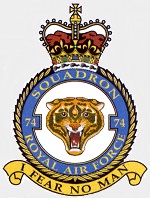Corgi AA35011 RAF Gloster Meteor F.8 Jet Fighter - No.74 Squadron, RAF St. Faith, Norfolk, 1954 (1:72 Scale)
"Never in the field of human conflict was so much owed by so many to so few."
- British Prime Minister Winston Churchill, commenting on the British airmen in the Battle of Britain
 The Gloster Meteor was the first British jet fighter and the Allies' first operational jet. Designed by George Carter, it first flew in 1943 and commenced operations on 27 July 1944 with 616 Squadron of the Royal Air Force (RAF). The Gloster Meteor was not an aerodynamically advanced aircraft, nor even the world's fastest aircraft on introduction, but the Gloster design team succeeded in producing an effective jet fighter that served the RAF and other air forces for decades. Meteors saw action with the Royal Australian Air Force (RAAF) in the Korean War and remained in service with numerous air forces until the 1970s.
The Gloster Meteor was the first British jet fighter and the Allies' first operational jet. Designed by George Carter, it first flew in 1943 and commenced operations on 27 July 1944 with 616 Squadron of the Royal Air Force (RAF). The Gloster Meteor was not an aerodynamically advanced aircraft, nor even the world's fastest aircraft on introduction, but the Gloster design team succeeded in producing an effective jet fighter that served the RAF and other air forces for decades. Meteors saw action with the Royal Australian Air Force (RAAF) in the Korean War and remained in service with numerous air forces until the 1970s.
In 1929, following Sir Frank Whittle's invention of the turbojet, development of a turbojet-powered fighter by Whittle's firm, Power Jets Ltd., and the Gloster Aircraft Company began in November 1940. The first British jet powered aircraft, the single-engined Gloster E28/39 prototype, had its maiden flight on 15 May 1941. The Air Ministry subsequently contracted for the development of a twin-engined jet fighter under Specification F9/40. Originally the aircraft was to have been named Thunderbolt, but to avoid confusion with the USAAF Republic P-47 Thunderbolt the name was changed to Meteor. The Meteor's construction was all-metal with a tricycle undercarriage and conventional low, straight wings, featuring turbojets mid-mounted in the wings with a high-mounted tailplane to keep it clear of the jet exhaust.
Eight prototypes were produced. Delays with getting type approval for the engines meant that although taxiing trials were carried out it was not until the following year that flights took place. The fifth prototype, DG206, powered by two de Havilland Halford H.1 engines due to problems with the intended Whittle W.2 engines, was the first to become airborne on March 5th, 1943 from RAF Cranwell, piloted by Michael Daunt Development then moved to Newmarket Heath and, later, a Gloster-owned site at Moreton Valence. The first Whittle-engined aircraft, DG205/G, flew on June 17th, 1943 (it crashed shortly after take-off on April 27th, 1944) and was followed by DG202/G in July. DG202/G was later used for deck-handling tests aboard aircraft carrier HMS Pretoria Castle. DG203/G made its first flight on November 9th, 1943 but was soon relegated to a ground instructional role. DG204/G (powered by Metrovick F.2 engines) first flew on November 13th, 1943, and crashed on April 1st, 1944. DG208/G made its debut on January 20th, 1944, by which time the majority of design problems had been identified and a production design approved. The two remaining prototypes never flew. DG209/G was used as an engine test-bed by Rolls-Royce. DG207/G was intended to be the basis for the Meteor F 2 with de Havilland engines, but when the engines were diverted to the de Havilland Vampire the idea was quietly forgotten.
Pictured here is a 1:72 scale replica of a Gloster Meteor F.8 jet fighter that was attached to No.74 Squadron, which was based at RAF St. Faith, Norfolk, during 1954.
Sold Out!
Dimensions:
Wingspan: 7-1/4-inches
Length: 6-3/4-inches
Release Date: January 2009
 Historical Account: "Teething Problems" - On January 12th, 1944, the first Meteor F 1, serial EE210/G, took to the air from Moreton Valence. It was essentially identical to the F9/40 prototypes except for the addition of four nose-mounted 20 mm Hispano cannon and some tweaks to the canopy to improve all-round visibility. For the production Meteor F 1, the engine was switched to the Whittle W.2 design, by then taken over by Rolls-Royce. The contemporary W.2B/23C turbojet engines produced 7.56 kN of thrust each, giving the aircraft a maximum speed of 417 mph (670 km/h) at 3,000 m and a range of 1,610 km. The Meteor Mk I was 12.5 m long with a span of 13.1 m, with an empty weight of 3,690 kg and a maximum takeoff weight of 6,260 kg.
Historical Account: "Teething Problems" - On January 12th, 1944, the first Meteor F 1, serial EE210/G, took to the air from Moreton Valence. It was essentially identical to the F9/40 prototypes except for the addition of four nose-mounted 20 mm Hispano cannon and some tweaks to the canopy to improve all-round visibility. For the production Meteor F 1, the engine was switched to the Whittle W.2 design, by then taken over by Rolls-Royce. The contemporary W.2B/23C turbojet engines produced 7.56 kN of thrust each, giving the aircraft a maximum speed of 417 mph (670 km/h) at 3,000 m and a range of 1,610 km. The Meteor Mk I was 12.5 m long with a span of 13.1 m, with an empty weight of 3,690 kg and a maximum takeoff weight of 6,260 kg.
Typical of early jet aircraft, the Meteor F 1 suffered from stability problems at high transonic speeds, experiencing large trim changes, high stick forces and self-sustained yaw instability (snaking) due to airflow separation over the thick tail surfaces.





![US M1A1 AIM Abrams Main Battle Tank with TUSK II Survival Kit and a Mine Plow [Plowing Mode] (1:72 Scale)](http://cdn4.volusion.store/qh9e9-jdqv9/v/vspfiles/photos/DRR63123-1.jpg?v-cache=1740197136)



